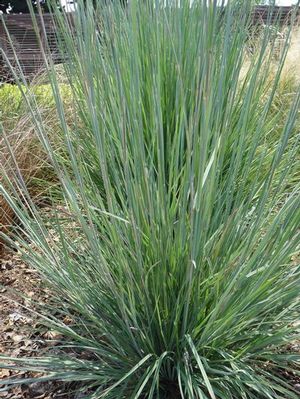New Moon Nurseries
Schizachyrium scoparium
Little bluestem - 2022 Perennial Plant of the Year
Native to North America
FIRST IMPRESSIONS: Schizachyrium scoparium is a mounding grass with narrow green or blue-green foliage. In late summer inconspicuous flowers are held on branched stems above the leaves. Fluffy light catching seed clusters follow. Foliage develops a coppery or amber hue in fall. Erect stems usually maintain their upright stance and glowing color through most of the winter. This handsome grass thrives in prairie type settings or in sunny gardens with mesic, average or dry soils.
HABITAT & HARDINESS: Schizachyrium scoparium ranges through most of the southern Canadian provinces and the contiguous United States. Distribution is sparse in the western states and the species is absent from Oregon and Nevada.
Plants are indigenous to prairies, barrens, sandy savannas, glades with limestone, sandstone or shale outcrops, thinly wooded rocky bluffs, open woods, sand dunes, dry roadsides, gravelly railroad right of ways and abandoned fields.
Schizachyrium scoparium is hardy from USDA Zones 4-10.
PLANT DESCRIPTION: Schizachyrium scoparium is a durable warm season bunch grass. Plants are upright or densely mounded with many vertical culms that grow from short rhizomes.
Spring leaves and stems often display an intense electric blue color. Mature blades have 1/4” width with green, gray-green or blue-green coloration and lavender tinged bases.
In late summer, branched flower stalks emerge and are held above the leaves. The 3” flower racemes bear purplish-bronze spikelets.
Clusters of fluffy silver seed heads follow. The spikelets are fairly inconspicuous but seedheads are showy especially when they glisten in the late afternoon sun.
Foliage develops lovely bronze, orange or reddish fall color. Usually Schizachyrium scoparium maintains its stunning amber foliage, striking vertical stems and handsome upright growth habit through winter.
Plants are anchored by a vigorous root system while top growth reaches 2-4’ with 2-3’ spread.
CULTURAL & MAINTENANCE NEEDS: Schizachyrium scoparium prospers in sunny sites with lean mesic to dry soils.
Plants tolerate clay, gravel, sand, alkalinity, drought, heat, humidity and moderate salinity but will languish if exposed to poor drainage, over-irrigation or flooding.
Avoid planting in shade or applying excessive fertilizer or water as these conditions promote weak sprawling stems.
The only maintenance needed is to cut or burn this grass to the ground in late winter.
LANDSCAPE USES: Schizachyrium scoparium is a striking vertical Accent or Mass Planting for Wildlife Gardens, Prairies or Meadows. This grass is a star of the Winter landscape. It also provides Erosion Control, Fall Color and Showy Seedheads. Plants are appropriate for Cottage Gardens, Low Maintenance Plantings, Water Wise Landscapes, Roadsides, Restoration Projects and Perennial Borders.
COMPANION & UNDERSTUDY PLANTS: Try pairing with Aster spectabilis, Chyrsopsis mariana, Coreopsis tripteris, Echinacea purpurea, Eupatorium hyssopifolium or Liatris microcephala.
Schizachyrium scoparium also mingles well with grasses like Andropogon gerardii, Bouteloua curtipendula, Danthonia spicata, Eragrostis spectabilis and Sporobolus heterolepis.
The cultivars ‘The Blues’ and ‘Standing Ovation’ have similar height, foliage and cultural needs and can be substituted if needed.
TRIVIA: Schizachyrium scoparium is a dominant species of the Midwestern Tallgrass Prairies. This grass along with Andropogon gerardii, Panicum virgatum and Sorghastrum nutans are sometimes called "The Four Horsemen of the Prairie".
Plants host the caterpillars of at least 6 species of skippers. The seed are eaten by a variety of small songbirds and young foliage is browsed by deer, bison and livestock.
Height:
2-4 ftSpread:
2-3 ftSpacing:
12-18 InchesUSDA Hardiness Zone:
4-10Bloom Color:
Green, TanSchizachyrium scoparium Characteristics
Attracts Wildlife
- Songbirds
- Pollinators
- Butterflies
Attributes
- Dried Flower
- Clay Soil
- Naturalizing
- Drought Tolerant
Exposure
- Full Sun to Partial Shade
Flowering Months
- September
Foliage Color
- Gray-Green
- Blue-Green
Grass Season
- Warm Season Grass
Growth Rate
- Medium
Juglans nigra Tolerance (Black Walnut)
- Yes
Phytoremediation
- Cu-Copper
Salt Tolerance
- High
Season of Interest (Foliage)
- Fall
- Summer
- Spring
- Winter
Soil Moisture Preference
- Dry
- Well-Drained
